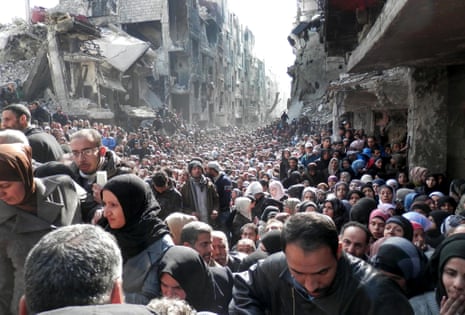The war in Syria has plunged 80% of its people into poverty, reduced life expectancy by 20 years, and led to massive economic losses estimated at over $200 billion since the conflict began in 2010, according to a UN-backed report.
The Syrian Centre for Policy Research painted a devastating picture of the “systematic collapse and destruction” of Syria’s economic foundations in the report, saying the nation’s wealth, infrastructure, institutions and much of its workforce have been “obliterated.”
Almost three million Syrians lost their jobs during the conflict, which meant that more than 12 million people lost their primary source of income, it said, and unemployment surged from 14.9% in 2011 to 57.7% at the end of 2014.
“As huge swatches of the community have lost the opportunity to work and earn an income, just over 4 in 5 Syrians now live in poverty,” the report said. “As it has become a country of poor people, 30% of the population have descended into abject poverty where households struggle to meet the basic food needs to sustain bare life.”
The report said the four-year-old conflict coupled with the country’s economic disintegration and social fragmentation have resulted in a 15% drop in Syria’s population — from 20.87 million in 2010 to just 17.65 million at the end of last year.
Syria now has the second-largest refugee population in the world after the Palestinians, with 3.33 million people fleeing to other countries, it said. In addition, 1.55 million Syrians left the country to find work and a safer life elsewhere while 6.8 million fled their homes but remain in Syria, it said.
The report, supported by the U.N. Development Program and the UN agency for Palestinian refugees, said that as Syria’s economy continues to deteriorate, total GDP loss is estimated at $119.7bn — accounting for 59% of the overall economic loss of $202.6bn by the end of 2014.
As violence intensified, it said, the number of deaths in the conflicts rose dramatically to 210,000. Together with the 840,000 wounded, this represented 6 percent of Syria’s population killed or injured during the conflict, it said.
“Equally horrendous is the silent disaster that has reduced life expectancy at birth from 75.9 years in 2010 to an estimated 55.7 years at the end of 2014, reducing longevity and life expectancy by 27%,” the report said.
It said education is also “in a state of collapse” with 50.8% of school-age children no longer attending school during 2014-2015 and almost half losing three years of schooling.

Comments (…)
Sign in or create your Guardian account to join the discussion